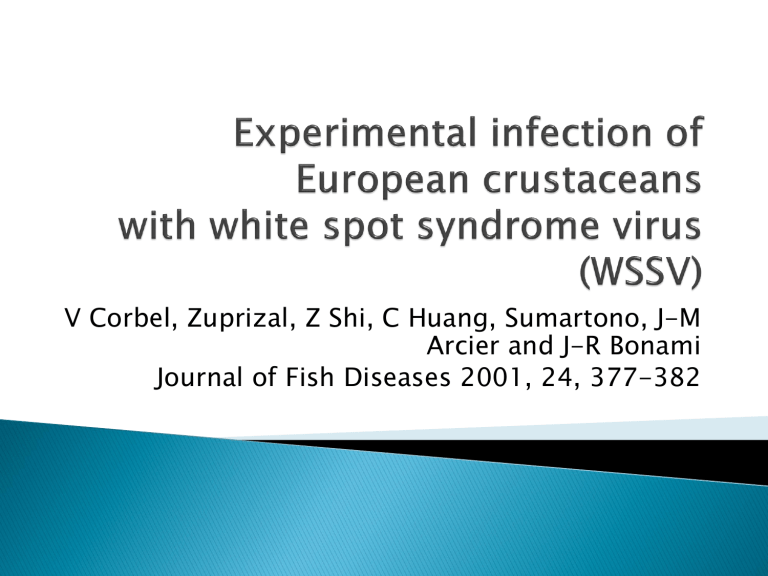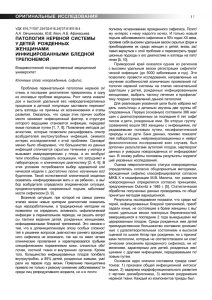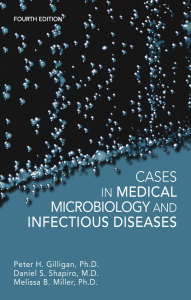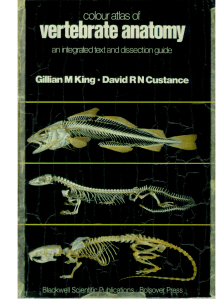
V Corbel, Zuprizal, Z Shi, C Huang, Sumartono, J-M Arcier and J-R Bonami Journal of Fish Diseases 2001, 24, 377-382 White spot syndrome virus (WSSV) is one of the names used for the virus causing white spot disease (WSD) in shrimp. The major clinical sign of this disease is the presence of white spots in the cuticle of heavily infected shrimp. Mortalities reach 100% within 3-8 days after infection with WSSV. Several reports have described the explosive epidemic character of WSD in penaeid shrimp production ponds. Detection of WSSV in cultured and wild shrimp, crabs and other arthropods has demonstrated the wide range of hosts for WSSV Shrimps infected by WSSV The crabs Liocarcinus depurator, L. puber, Cancer pagurus and C. maenas, the freshwater crayfish, Astacus leptodactylus and Orconectes limosus, the common Mediterranean grey shrimp, Palaemon adspersus and a lobster, Scyllarus arctus were inoculated using a tuberculin syringe with 0.1 or 0.2 mL (depending on the size of the experimental host) of haemolymph obtained from shrimp, Penaeus monodon, infected with WSSV. For per os infections, animals were fed with sliced, previously frozen, PCR-positive, WSSV infected shrimp during the first day of the experiment. Thereafter, they were given normal feed. Clinical signs of infection and mortality of the animals were subsequently recorded daily. Haemolymph was withdrawn from moribund and dead animals using a syringe and examined by direct TEM. Carcasses and haemolymph were stored at -20 °C until further analysis. Collected haemolymph and puri®ed virus suspensions were negatively stained with 2% sodium phosphotungstate (PTA, pH 7.0) on collodoin-carbon coated grids. Haemolymph of animals was boiled for 5 min at 100 °C, then centrifuged at low speed. One lL of clarified suspension was spotted on a positively charged nylon membrane and fixed with UV for 3 min. Hybridization followed the protocol of Durand et al. Samples of healthy and infected animals were fixed in Davidson's fixative and subsequently paraffin embedded. Sections (4-6 μm thick) were mounted onto positively charged microscope slides (polylysine treated) and were used for in situ hybridization using digoxigenin labelled probes according to the protocol described by Durand et al. Sections of healthy animals were also used to test the probe specificity. Samples of healthy and infected tissues held at 4 °C, were homogenized and centrifuged for 10 min at 100 000 g. The supernatant was boiled for 10 min. The PCR reaction solution contained buffer 1X (100 mm Tris-HCl, 150 mm NaCl, pH 7), MgCl2 at 2.5 mm, digoxigenin labelled nucleotide, a mix of nucleotides (2.5 mm for each dNTP), primers sL46 and asL46 (0.5 μm), 2 units of Taq polymerase and 1 μL of the sample supernatant (infected or healthy gills and pleopods) for a final volume of 50 μL. The primers were determined from the sequence of the L46 WSSV-genome fragment. Clinical signs were observed after 3 days postinjection for L. puber and L. depurator and mortality reached 50%. Successful WSSV infections in all of the crustaceans caused a rapid reduction in feed intake and lethargy, as in infected shrimp. The affected crabs (especially L. puber) displayed pale discolouration and appeared very weak. Moribund L. puber had some white spots on their legs. All the injected decapod species in this experiment showed between 70 and 100% mortality by 20 days post-infection. It was common to see a rapid increase in mortality over 4 or 5 days, which is generally characteristic of viral infections. However, no white spots were observed in the cuticle of moribund or dead animals (except for L. puber), possibly as a result of the rapid mortality after injection All species infected per os or by injection, except C. maenas, showed enveloped virions, free nucleocapsids and free viral envelope fragments WSSV in haemolymph of infected Liocarcinus depurator. Enveloped virion (large arrowhead) and nucleocapsid (small arrowhead) Most of the samples tested (L. depurator, L. puber, C. pagurus, A. leptodactylus, O. limosus, P. adspersus and S. arctus) showed positive hybridization spots with the two probes. Positive hybridization reactions were also seen in species infected per os (S. arctus, A. leptodactylus, L. puber, P. adspersus and C. pagurus). No reaction was observed in the negative control animals or in the gills and the haemolymph from C. maenas. Dot-blot of infected gill samples from Palaemon adspersus. Positive hybridization reactions are seen for many of the infected dead animals, while there is no reaction with sterile water and the negative control (healthy gill sample): T.: positive control, Tÿ: negative control, SW: sterile water, IfD: infected dead animals In infected animals, subcuticular cells, connective tissue, heart muscle, and cells in the haemal sinuses of the hepatopancreas gave strong hybridization reactions (Figs 3±5). No hybridization was seen in the tissues of healthy animals. In situ hybridization in infected gill sections from Astacus leptodactylus. The nuclei of the epidermis (arrows) and connective tissue cells show strong hybridization (black) reactions In situ hybridization in infected gill sections of Cancer pagurus. Nuclei of the subepithelial cells (arrows) are strongly labelled A positive amplification reaction, visualized as a specific fragment of 494 bp, was observed in all of the samples tested, except the tissue of a healthy animal PCR diagnosis of infected gill extracts from Liocarcinus puber. L: 100 pb ladder, 1: sterile water, 2: negative control, 3-7: infected samples. The ease in obtaining experimental WSSV infections per os or by injection in European crustaceans shows that this agent must be considered as a potential threat to these species.



